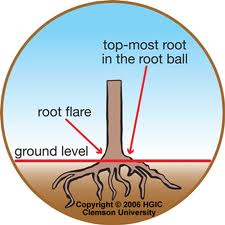
by Sheila Dunning | Jan 19, 2018
We plant trees with the intention of them being there long after we are gone. However, m any trees and shrubs fail before ever reaching maturity. Often this is due to improper installation and establishment. Research has shown that there are techniques to improve survivability. Before digging the hole:
any trees and shrubs fail before ever reaching maturity. Often this is due to improper installation and establishment. Research has shown that there are techniques to improve survivability. Before digging the hole:
- Look up. If there is a wire, security light, or building nearby that could interfere with proper development as it grows, plant elsewhere.
- Dig a shallow planting hole as wide as possible. Shallow is better than deep! Many people plant trees too deep. A hole about one-and-one-half the diameter of the width of the root ball is recommended. Wider holes should be used for compacted soil and wet sites. In most instances, the depth of the hole should be LESS than the height of the root ball, especially in compacted or wet soil. If the hole was inadvertently dug too deep, add soil and compact it firmly with your foot. .
- Find the point where the top-most root emerges from the trunk. If this is buried in the root ball then remove enough soil from the top so the point where the top-most root emerges from the trunk is at the surface. Burlap on top of the ball may have to be removed to locate the top root.
- Slide the plant carefully into the planting hole. To avoid damage when setting a large tree in the hole, lift the tree with straps or rope around the root ball, not by the trunk. Special strapping mechanisms need to be constructed to carefully lift trees out of large containers.
- Position the plant where the top-most root emerges from the trunk slightly above the landscape soil surface. It is better to plant a little high than to plant it too deep. Remove most of the soil and roots from on top of the root flare and any growing around the trunk or circling the root ball. Once the root flare is at the appropriate depth, pack soil around the root ball to stabilize it. Soil amendments are usually of no benefit. The soil removed from the hole and from on top of the root ball makes the best backfill unless the soil is terrible or contaminated. Insert a square-tipped balling shovel into the root ball tangent to the trunk to remove the entire outside periphery. This removes all circling and descending roots on the outside edge of the root ball.
- Straighten the plant in the hole. Before you begin backfilling have someone view the plant from two directions perpendicular to each other to confirm that it is straight. Break up compacted soil in a large area around the plant provides the newly emerging roots room to expand into loose soil. This will hasten root growth translating into quicker establishment Fill in with some more backfill soil to secure the plant in the upright position.
- Remove synthetic materials from around trunk and root ball. Synthetic burlap needs to be completely removed from the root ball; treated burlap can be left in place. String, strapping, plastic, and other materials that will not decompose and must be removed from the trunk at planting. Remove the wire above the soil surface from wire baskets before backfilling.
- Apply a 3-inch-layer of mulch. To retain moisture and suppress weeds cover the outer half of the root ball with an organic mulch. Do not cover the stem of the plant or the connecting root flare.
- Water consistently until established. For nursery stock less than 2-inches in caliper, this will require every other day for 2 months, followed by weekly 3-4 months. At each irrigation, apply 2 to 3 gallons of water per inch trunk caliper directly over the root ball. Never add irrigation if the ground is saturated.
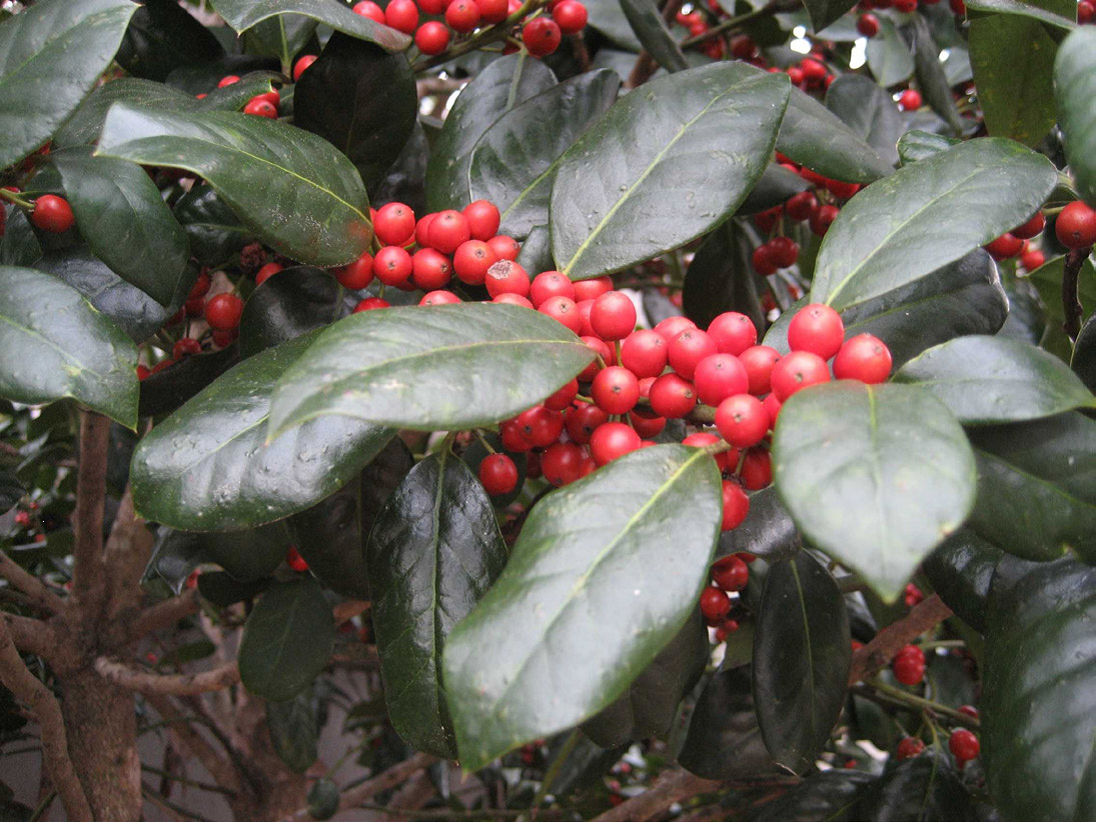
by Sheila Dunning | Dec 15, 2017
According to Druid lore, hanging the plant in homes would bring good luck and protection. Holly was considered sacred because it remained green and strong with brightly colored red berries no matter how harsh the winter. Most other plants would wilt and die.
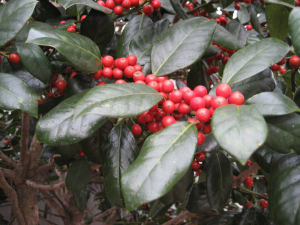 Later, Christians adopted the holly tradition from Druid practices and developed symbolism to reflect Christian beliefs. Today, the red berries are said to represent the blood that Jesus shed on the cross when he was crucified. Additionally, the pointed leaves of the holly symbolize the crown of thorns Jesus wore on his head.
Later, Christians adopted the holly tradition from Druid practices and developed symbolism to reflect Christian beliefs. Today, the red berries are said to represent the blood that Jesus shed on the cross when he was crucified. Additionally, the pointed leaves of the holly symbolize the crown of thorns Jesus wore on his head.
Several hollies are native to Florida. Many more are cultivated varieties commonly used as landscape plants. Hollies (Ilex spp.) are generally low maintenance plants that come in a diversity of sizes, forms and textures, ranging from large trees to dwarf shrubs.
The berries provide a valuable winter food source for migratory birds. However, the berries only form on female plants. Hollies are dioecious plants, meaning male and female flowers are located on separate plants. Both male and female hollies produce small white blooms in the spring. Bees are the primary pollinators, carrying pollen from the male hollies 1.5 to 2 miles, so it is not necessary to have a male plant in the same landscape.
Several male hollies are grown for their compact formal shape and interesting new foliage color. Dwarf Yaupon Hollies (Ilex vomitoria ‘Shillings’ and ‘Bordeaux’) form symmetrical spheres without extensive pruning. ‘Bordeaux’ Yaupon has maroon-colored new growth. Neither cultivar has berries.
Hollies prefer to grow in partial shade but will do well in full sun if provided adequate irrigation. Most species prefer well-drained, slightly acidic soils. However, Dahoon holly (Ilex cassine) and Gallberry (Ilex glabra) naturally occurs in wetland areas and can be planted on wetter sites.
Evergreen trees retain leaves throughout the year and provide wind protection. The choice of one type of holly or another will largely depend on prevailing environmental conditions and windbreak purposes. If, for example, winds associated with storms or natural climatic variability occur in winter, then a larger leaved plant might be required.
The natives are likely to be better adapted to local climate, soil, pest and disease conditions and over a broader range of conditions. Nevertheless, non-natives may be desirable for many attributes such as height, growth rate and texture but should not reproduce and spread beyond the area planted or they may become problematic because of invasiveness.
There is increasing awareness of invasiveness, i.e., the potential for an introduced species to establish itself or become “naturalized” in an ecological community and even become a dominant plant that replaces native species. Tree and shrub species can become invasive if they aggressively proliferate beyond the windbreak. At first glance, Brazilian pepper (Schinus terebinthifolius), a fast-growing, non-native shrub that has a dense crown, might be considered an appropriate red berry producing species. However, it readily spreads seed disbursed by birds and has invaded many natural ecosystems. Therefore, the Florida Department of Environmental Protection has declared it illegal to plant this tree in Florida without a special permit. Consult the Florida Exotic Pest Plant Council’s Web page (www.fleppc.org) for a list of prohibited species in Florida.
For a more comprehensive list of holly varieties and their individual growth habits refer to ENH42 Hollies at a Glance: http://edis.ifas.ufl.edu/mg021
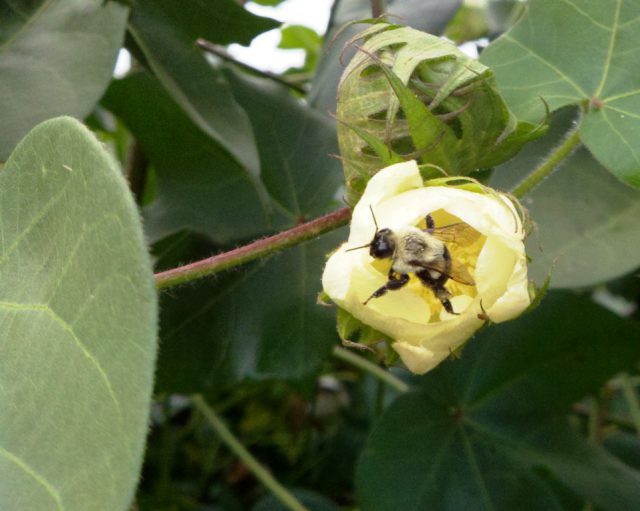
by Judy Biss | Sep 22, 2017

Cotton is largely self-pollinating but attractive to bees. Pollination by bees can increase seed set per boll. Photo by Judy Biss
“The happiness of the bee and the dolphin is to exist.
For man it is to know that and to wonder at it.”
Jacques Yves Cousteau
Bumble bees are among the most recognizable types of insects. They are large, colorful, and a wonder to watch. They’re also popularized in media, cartoons, and clip-art images, but beyond the popular images, bumble bees are worthy of our attention as important pollinators of both native plants and agricultural crops. They are one of hundreds of pollinating bees that are critical to the abundance of our native lands, wildlife, and also our food supply. Protection of pollinators has received national recognition and many programs are now geared towards pollinator conservation.
Why is Pollinator Protection Important?
According to the UF/IFAS publication Minimizing Honey Bee Exposure to Pesticides:
The western honey bee is conceivably the most important pollinator in Florida and American agricultural landscapes. The honey bee is credited with approximately 85% of the pollinating activity necessary to supply about one-quarter to one-third of the nation’s food supply. Over 50 major crops in the United States and at least 13 in Florida either depend on honey bees for pollination or produce more abundantly when honey bees are plentiful.
And:
“Growers also use other managed bees species, such as the bumble bee to provide field and greenhouse crop pollination services. Additionally, there are more than 315 species of wild/unmanaged bees in Florida that play a role in the pollination of agricultural crops and natural and managed landscapes. These include mining bees, mason bees, sweat bees, leafcutter bees, feral honey bees, and carpenter bees, among others.”
Pollinator Protection was formally recognized at the federal level in 2014 when the President of the United States signed an official memorandum entitled: Creating a Federal Strategy to Promote the Health of Honey Bees and Other Pollinators which outlines specific steps to increase and improve pollinator habitat. These steps are geared towards protecting and restoring populations of not only honey bees, but native bees, birds, bats, and butterflies; all of which are vital to our nation’s economy, food production, and environmental health.
Bumble Bee Biology and Ecology
There is much to learn about these fascinating insects. Here are some facts to feed your curiosity. Additional resources are listed at the end of this article.
- Bumble bees belong to the genus Bombus within the family Apidae. As such, they are related to honey bees, carpenter bees, cuckoo bees, digger bees, stingless bees, and orchid bees.
- There are about 50 species of North American bumble bees.
- Bumble bees are social and form colonies like honey bees do, but bumble bee colonies are smaller (50 – 500 individuals) and their colonies only last one season.
- Bumble bees generally make their nests in the ground using abandoned rodent cavities or under old tree roots, etc.
- Each spring, a mated queen emerges from winter hibernation and finds a suitable underground cavity. She begins collecting nectar and pollen and laying eggs to build her colony.
- By late summer and into fall, the only surviving member of the colony are new queens.
- These queens mate and then they hibernate during winter 2-5 inches deep in the soil. The following spring these queens emerge and start new colonies, repeating the annual cycle.
- Bumble bees are adapted to a wide range of environmental conditions and can forage in cooler, cloudier, and wetter weather better than other bees. Because of this adaptation, they are generally the first bees out in early spring and the last bees out in the fall.
- Since bumble bees are adapted to a wide range of environmental conditions, they are also able to feed on a wide variety of flowering plants.
- Bumble bees do make honey, but only enough to feed the colony during bad weather when they are unable to go out and forage.
- Bumble bees, like the blueberry bee collect pollen from certain flowers using a unique behavior called “buzz pollination,” or “sonication.” This behavior is not found in European honey bees. Some plants, blueberries for example, hold tightly to their tiny pollen. Bumble bees and blueberry bees grab the flower structure and powerfully vibrate their wings while holding onto the flower. Their whole body vibrates and literally shakes the pollen lose from the flower.
- Besides blueberries, other commercially important food crops that benefit from “buzz pollination” include, tomatoes, peppers, and cranberries.
- Bumble bees are so effective at pollinating important food crops that they are raised commercially and sold to greenhouses to pollinate produce such as tomatoes, peppers, and strawberries.
Create Your Own Pollinator Pasture
You can help increase the abundance and health of bumble bees, other native pollinators, and honey bees by creating nectar and pollen rich bee pastures. These pastures can be filled with annual plants, which grow from seed each year, perennial plants, which return and spread on their own each year, various flowering shrubs and trees, or any mixture of above. You can also manage existing natural areas and woodlands by employing recommended prescribed fire regimes, non-native invasive plant control, and other practices to encourage a diversity of native pollinator plants.
The ideal bee pasture is one in which flowers are blooming as continuously as possible throughout the year. Research shows bees thrive best in open sunny pastures that are as large as possible, with a diversity of plants types. While flowering shrubs along woodland edges are well used by bees, a bee pasture that is allowed to become dominated by trees and shade will become less attractive to bees. A dedicated, open, sunny pasture having nectar and pollen plant diversity is best. Just as with any field you intend to plant, the first step is to collect a soil sample for analysis of existing nutrients and pH levels. (For more information on soil samples read the article Soil Test First!
Pollinator Plant Types
There are many plants that provide nutritious nectar and pollen for north Florida’s pollinators. Some examples of plants which are good pollinator food sources are maple trees, redbuds, poplars, gallberries, blackberries, palmettos, partridge pea, mint, thistles, goldenrod, asters, tickseeds, sunflowers, squash, melons, and clovers. If you purchase a bee pasture blend from a seed company, make sure it is suited for growing in north Florida and does not contain noxious, invasive, weedy plant species. The Florida Exotic Pest Plant Council maintains a listing of documented invasive plants here: List of Invasive Plant Species.
Summary and Resources
The business, biology, and botany of pollination is fascinating and critical to sustainable and diverse food production in Florida and the United States. Bumble bees are just one of the many native pollinators that frequent our forests, fields, and gardens. Consider turning your fallow lands or backyards into productive bee pasture and reap a sweet harvest.
For more information please see the resources used for this article below:
by Erik Lovestrand | Feb 27, 2017
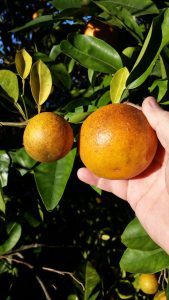
Fruits on HLB infected trees ripen prematurely, are small, and often drop from tree. Photo credit: Erik Lovestrand
If we look at the big picture when it comes to invasive species, some of the smallest organisms on the planet should pop right into focus. A microscopic bacterium named Candidatus Liberibacter asiaticus, the cause of Citrus Greening (HLB), has devastated the citrus industry worldwide. This tiny creature lives and multiplies within the phloem tissue of susceptible plants. From the leaves to the roots, damage is caused by an interruption in the flow of food produced through photosynthesis. Infected trees show a significant reduction in root mass even before the canopy thins dramatically. The leaves eventually exhibit a blotchy, yellow mottle that usually looks different from the more symmetrical chlorotic pattern caused by soil nutrient deficiencies.
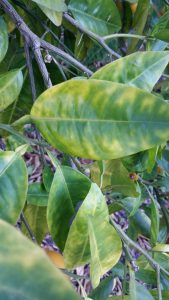
HLB, referred to as “Yellow Dragon” in China, causes an asymmetrical pattern of chlorosis in citrus leaves. Photo credit: Erik Lovestrand
One of the primary vectors for the spread of HLB is an insect called the Asian citrus psyllid. These insects feed by sucking juices from the plant tissues and can then transfer bacteria from one tree to another. HLB has been spread through the use of infected bud wood during grafting operations also. One of the challenges with battling this invasive bacterium is that plants don’t generally show noticeable symptoms for perhaps 3 years or even longer. As you would guess, if the psyllids are present they will be spreading the disease during this time. Strategies to combat the impacts of this industry-crippling disease have involved spraying to reduce the psyllid population, actual tree removal and replacement with healthy trees, and cooperative efforts between growers in citrus producing areas. You can imagine that if you were trying to manage this issue and your neighbor grower was not, long-term effectiveness of your efforts would be much diminished. Production costs to fight citrus greening in Florida have increased by 107% over the past 10 years and 20% of the citrus producing land in the state has been abandoned for citrus.
Many scientists and citrus lovers had hopes at one time that our Panhandle location would be protected by our cooler climate but HLB has now been confirmed in more than one location in backyard trees in Franklin County. The presence of an established population of psyllids has yet to be determined, as there is a possibility infected trees were brought in.
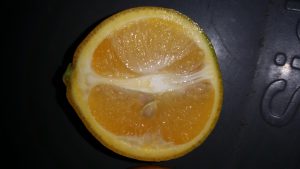
Another symptom of citrus greening is small, lopsided fruit that are often bitter. Photo credit: Erik Lovestrand
A team of plant pathologists, entomologists, and horticulturists at the University of Florida’s centers in Quincy and Lake Alfred and extension agents in the panhandle are now considering this new finding of HLB to help devise the most effective management strategies to combat this tiny invader in North Florida. With no silver-bullet-cure in sight, cooperative efforts by those affected are the best management practice for all concerned. Vigilance is also important. If you want to learn more about HLB and other invasive species contact your local UF/IFAS Extension office.
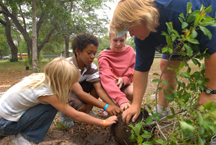
by Sheila Dunning | Jan 20, 2017

4H youth assist an IFAS Extension agent in planting a tree. July 2008 IFAS Extension Calendar Photo. 4H children planting a small tree. 4H Club, youth groups, planting. UF/IFAS Photo: Josh Wickham.
Florida has celebrated Arbor Day since 1886 and has one of the first Arbor Day celebrations in the nation, on the third Friday in January. Trees establish a root system quickly when they aren’t expending as much energy on leaf development. So in Florida that is in the winter months; hence the reason for a January date for Arbor Day. However, installation anytime between October and March are suitable for most tree species. Palms are the exception. They require warm soil in order to root, so it best to plant them from April to August.
Planting and establishing trees is all about managing air and water in the soil. Three of the most common causes of poor plant establishment or even death include installing too deeply, under watering, and over watering. By selecting the appropriate species for the site, planting it at the correct depth, and irrigating properly trees should establish successfully. As simple as that sounds, many trees fail before they ever mature in the landscape.
Here are the ten steps to proper tree planting:
- Look up for wires and lights when choosing a site. Make sure that the location is more than 15 feet from a structure. Call 811 for underground utilities spotting at no cost.
- Remove any synthetic or metal materials from the top of the root ball.
- Find the topmost root (where the trunk meets the roots) and remove root defects, such as encircling roots. Loosed the root ball.
- Dig a shallow container-sized hole.
- Carefully place the tree in the hole. Don’t damage the trunk or break branches.
- Position the topmost root 1-2 inches above the soil grade.
- Straighten the tree. Be sure to check from two directions.
- Widen the hole to add backfill soil.
- Water to check for air pockets and hydrate the root ball. Add 3-4 inch thick layer of mulch at the edge of the root ball, with little to no mulch on top of the root ball.
- Prune for structural strength and damage removal. Stake if necessary in windy areas or if required by code.
These are probably not the steps used by previous generations. Twenty years of research has improved the techniques required for tree survival. Every year more and more trees are removed from storm damage, pest infestations, and development. Winter is time to add them back to both the urban and rural environments. Celebrate Arbor Day. Plant a tree. But, install it properly. Give your grandchildren the opportunity to enjoy it well into their adulthood.
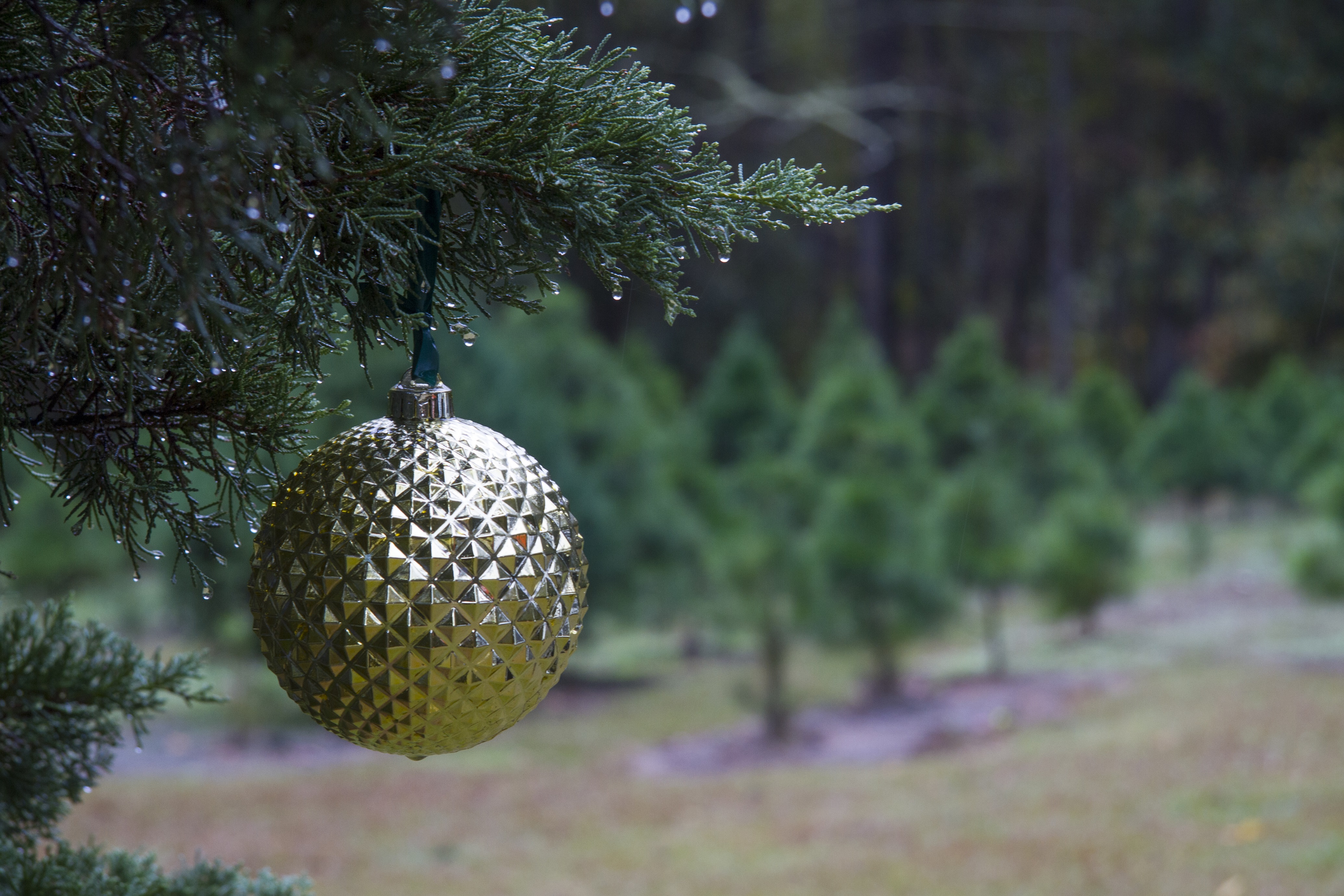
by hollyober | Dec 16, 2016

Christmas trees can provide benefits to wildlife long after they have served as holiday decoration indoors. Credits: IFAS photo database.
Americans purchased approximately 30 million live Christmas trees last year. If you plan to have a live tree this winter, and you’re wondering what you could do with your tree once it has finished its role as holiday decoration in your home, read below. Rather than simply dragging your tree to the curb for the waste disposal truck to pick up, you could prolong the life of your holiday tree by repurposing it to benefit wildlife.
YOUR TREE COULD PROVIDE FOOD FOR WILDLIFE
Many of the needles may have dropped from your Christmas tree as it dried out while indoors, but the branches should still be intact. This means your tree could be used as a frame to present food for wildlife. After removing your indoor decorations, consider propping the tree up in your yard (perhaps using the same stand you used indoors), and adorning the branches with food enjoyed by wildlife visitors. Some low-budget options include mesh bags filled with bird seed (black oil sunflower seed, safflower seed, and thistle (nyjer) are favorites of many common backyard birds), pine cones smeared with peanut butter, home-made suet cakes, and strings of fruit such as apple slices, orange slices, or grapes. If you choose this option, beware that you may attract not only birds, but mammals such as squirrels, raccoons, opossums, and others.
If you’d like to watch your wildlife visitors, be sure to attach the food items with string so that the animals must eat the food at the site of the tree rather than carrying it away to eat or store elsewhere out of view. Consider using a biodegradable string (i.e., cotton) to secure the food items to your tree so you can eventually compost the tree without worrying about needing to remove the string.
YOUR TREE COULD PROVIDE SHELTER FOR WILDLIFE
If you’re tired of seeing your holiday tree in its upright position, consider taking it outdoors, laying it down, and heaping other vegetative debris loosely on top to form a ‘brush pile’. Brush piles are mounds of woody vegetation created specifically to provide shelter for wildlife.
The lower portions of a brush pile can offer cool, shaded conditions that allow small mammals such as rabbits to hide from the weather and from predators. Meanwhile, the upper portions can serve as perch sites for songbirds. The entire pile may be used as resting sites for amphibians and reptiles. In yards with few understory trees or shrubs, and at times of year when many trees and shrubs have limited foliage, these brush piles can provide much-appreciated cover for many kinds of wildlife.
YOUR TREE COULD PROVIDE SHELTER FOR FISH
Your retired Christmas tree could be used to make long-lasting habitat improvements for fish. In artificial ponds with little submerged vegetation, the addition of one or more Christmas trees could upgrade the quality of refuge and feeding areas for fish. Small fishes may hide among purposely submerged Christmas trees for protection, and larger fishes may follow them. If you’ve got an artificial pond on your property, consider adding discarded trees to create a place where fish can hide and find food, and also to concentrate fish for angling. Simply secure a cinder block to your holiday tree using heavy wire or thin cable and place it far enough from shore that water covers the top of the tree by a couple of feet. When constantly submerged, Christmas trees can persist for many years underwater.
Not only can your tree offer enjoyment to you when decorated with lights and ornaments indoors, but it can also allow you to provide post-holiday gifts to the wildlife and fish on your property.

 any trees and shrubs fail before ever reaching maturity. Often this is due to improper installation and establishment. Research has shown that there are techniques to improve survivability. Before digging the hole:
any trees and shrubs fail before ever reaching maturity. Often this is due to improper installation and establishment. Research has shown that there are techniques to improve survivability. Before digging the hole:









